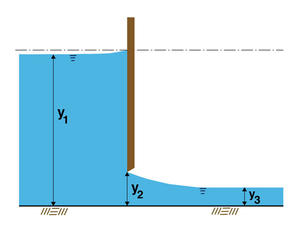Flow under a sluice gate
Today we are going to demonstrate
the flow under a sluice gate using the energy principle.
...
...
The theoretical formula based on the conservation of specific energy is:
...
in which Q is the discharge, B is the width of the flume, y1 is the upstream flow depth, y3 is the downstream flow depth, and g is the acceleration of gravity.
For practical purposes, this theoretical formula can be expressed in terms of the gate opening y2
by defining a contraction ratio Cc:
...
This leads to:
...
in which the discharge coefficient Cd is:
[Point to the width of the flume] The width B of the flume is 6 inches, or 152.4 mm.
...
We set the gate opening y2 = 15 mm
...
We turn on the pump.
...
We set the bed slope equal to zero...
and check the level...
...
[Point to the point gage] Note that the point gage is at zero at the bottom of the flume.
...
Now we are going to measure the upstream flow depth y1.
...
The upstream flow depth is y1 = X mm
...
We move the gage downstream of the sluice gate.
...
[Point to the point gage] Note that the point gage is at zero at the bottom of the flume.
...
Now we are going to measure the downstream flow depth y3.
...
The downstream flow depth is y3 = X mm
Applying the theoretical equation based on the conservation of specific energy, the discharge is Q1 = X liters per second.
...
Next we calculate Cc and Cd.
...
With these coefficients we calculate Q2 = X liters per second.
...
Note that both equations give the same answer:

Q1 = B y1 y3 [ 2g / (y1 + y3) ]1/2
Cc = y3 / y2
Q2 = B Cd y2 (2g y1)1/2
Cd = Cc / [ 1 + Cc (y2 / y1)]1/2
